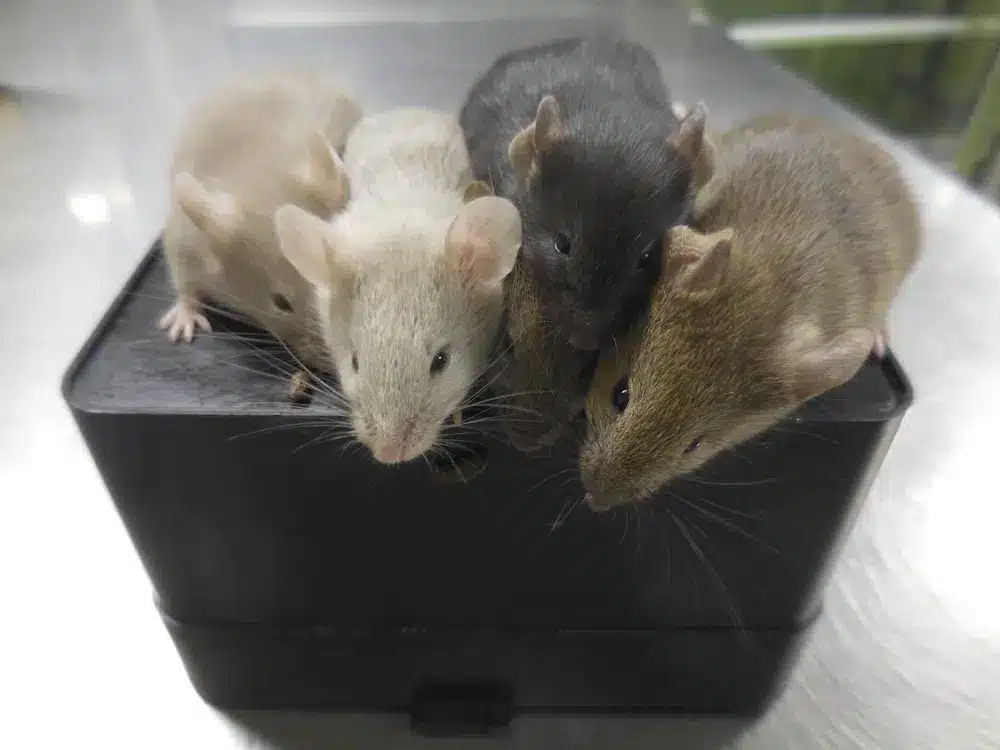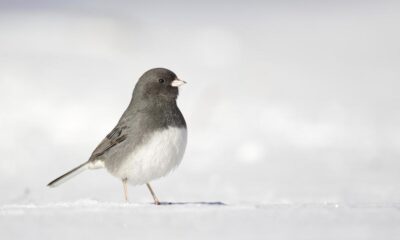Science
Scientists Create Mice With Cells From 2 Males For 1st Time

Scientists have produced baby mice from two guys for the first time.
Although specialists caution that only a few mice embryos matured into live mouse pups, and no one knows whether it will work for humans, this raises the remote potential of employing the same approach on people.
But even so, “It’s a pretty creative method,” said Diana Laird, a stem cell and reproductive person at the University of California, who was not involved in the study. It’s a crucial phase in both reproductive biology and stem cell research.
Researchers revealed their work in a paper published in the journal Nature on Wednesday.
First, they created “induced pluripotent stem cells” from skin cells removed from the tails of male mice. These cells can differentiate into a variety of different cell or tissue types. They then developed functioning egg cells by converting male mouse stem cells into female cells by expanding them and administering medication. The embryos were then placed into female mice after being fertilized. 7 of the 630 embryos, or around 1%, developed into living mouse pups.
Last week, scientists at the Third International Conference on Human Genome Editing heard from research leader Katsuhiko Hayashi of Kyushu University and Osaka University in Japan that the pups appeared to develop properly and could become parents on their own in a typical way.
Laird and her colleague Jonathan Bayerl wrote a commentary that was published alongside the Nature publication in which they stated that the work “opens up new pathways in reproductive biology and mice fertility research” for both people and animals. In the future, it is feasible to procreate endangered mammals from a single male.
Unclear why so few embryos implanted into surrogate mice survived.
They said it “could even give a pattern for enabling more people to produce biological children while avoiding the ethical and legal concerns of donor eggs,” such as male same-sex couples.
However, they issued multiple warnings. Which is the most notable? The method could be more effective. They claimed it was unclear why so few embryos implanted into surrogate mice survived; there may be technical or biological reasons for this. However, they emphasized that it is still too early to determine whether the approach would even function with human stem cells.
Before employing stem cells to create eggs, Laird added that researchers must consider the mutations and mistakes that might be made in a culture dish.
The most recent study explores novel approaches to in vitro mouse embryogenesis. This summer, researchers in Israel and California developed “synthetic” mouse embryos from stem cells that lacked a mother’s ovum or egg. Up to 8 12 days after conception, those mice embryos had the same characteristics as typical mouse embryos, including one that resembled a beating heart. The achievement, according to scientists, could one day serve as a model for producing artificial human embryos for future research.
SOURCE – (AP)
Science
NASA Astronauts Will Stay At The Space Station Longer For More Troubleshooting Of Boeing Capsule

Two NASA astronauts will stay longer at the International Space Station as engineers work to resolve issues with Boeing’s new space capsule that arose during the mission.
NASA announced on Friday that the astronauts would not return until ground testing was completed and that they were safe.
“We’re not in a hurry to come home,” said NASA’s commercial crew program manager, Steve Stich.
NASA | AP News Image
NASA Astronauts Will Stay At The Space Station Longer For More Troubleshooting Of Boeing Capsule
Butch Wilmore and Suni Williams, veteran NASA test pilots, launched aboard Boeing’s Starliner spacecraft toward the orbiting laboratory on June 5. Boeing’s first astronaut launch came after years of delays and disappointments.
The test voyage was intended to last about a week, giving Wilmore and Williams adequate time to inspect the capsule while docked at the station. However, issues with the capsule’s propulsion system, which is used to steer the spacecraft, forced NASA and Boeing to postpone the flight home many times while investigating the issue.
They also sought to avoid station astronauts interfering with spacewalks. However, this week’s spacewalk was canceled due to water leaking from an astronaut’s spacesuit. The problem still needs rectification, and the planned spacewalk next week has been postponed.
As Starliner approached the space station a day after launch, last-minute thruster malfunctions nearly ruined the docking. Five of the capsule’s 28 engines failed during docking; only one was restarted.
NASA | AP news Image
NASA Astronauts Will Stay At The Space Station Longer For More Troubleshooting Of Boeing Capsule
When the Starliner launched into orbit, it already had one minor helium leak, and numerous more appeared during the voyage. Helium is utilized to pressurize the fuel for the thruster. Boeing stated that the two issues are not a worry for the return trip.
NASA and Boeing delayed the astronauts’ return because they required extra time to gather information about the thruster problems and leaks while the spacecraft was docked. Both are in the service module, a device attached to the capsule that burns up during reentry.
NASA initially stated that the Starliner might stay docked at the space station for up to 45 days owing to battery limitations. However, according to Stich, in-flight studies have proven that the limit can be expanded.
Officials said they would wait to set a return date while conducting ground tests of capsule thrusters in the New Mexico desert, estimated to take a few weeks. They want to try to duplicate what happened during docking.
“I want to make it very clear that Butch and Suni are not stranded in space,” said Stich, adding that Starliner is designed for up to 210-day missions.
NASA | AP news Image
NASA Astronauts Will Stay At The Space Station Longer For More Troubleshooting Of Boeing Capsule
Stich stated that if the space station experiences an emergency, the astronauts could return to Earth via Starliner.
After the space shuttle fleet terminated, NASA handed astronaut rides to private businesses. Elon Musk’s SpaceX has completed nine taxi flights for NASA since 2020. NASA intends to alternate between SpaceX and Boeing in transporting astronauts to and from the space station.
SOURCE – (AP)
World
Why Mount Rainier Is The US Volcano Keeping Scientists Up At Night

Mount Rainier, Washington’s snowcapped peak that stands 4.3 kilometers (2.7 miles) above sea level, has not had a significant volcanic eruption in the last 1,000 years. More than Hawaii’s exploding lava fields or Yellowstone’s vast supervolcano, Mount Rainier has many US volcanologists concerned.
“Mount Rainier keeps me awake at night because it poses a significant threat to the nearby villages. “Tacoma and South Seattle are built on 100-foot-thick (30.5-meter) ancient mudflows from Mount Rainier eruptions,” said Jess Phoenix, a volcanologist and ambassador for the Union of Concerned Scientists, on an episode of CNN’s “Violent Earth With Liv Schreiber.”

Volcano | CNN Image
Why Mount Rainier Is The US Volcano Keeping Scientists Up At Night
The sleeping giant’s deadly potential does not stem from flaming lava flows, which, in the case of an eruption, are unlikely to spread more than a few miles beyond the boundary of Mount Rainier National Park in the Pacific Northwest. According to the US Geological Survey, most volcanic ash will likely drift downwind to the east, away from populated centers.
Instead, many scientists are concerned about a lahar, a fast-moving slurry of water and volcanic rock formed when ice or snow is rapidly melted by an eruption. Lahars gather debris as they run down valleys and drainage channels.
According to Seth Moran, a research seismologist at USGS Cascades Volcano Observatory in Vancouver, Washington, Mount Rainier’s tall height and ice and snow cover make it resilient to eruptive activity. “Hot stuff … will melt the cold stuff and a lot of water will start coming down,” he explained.
“And there are tens, if not hundreds of thousands of people who live in areas that potentially could be impacted by a large lahar, and it could happen quite quickly.”
A lahar is a rapidly flowing debris flow.
The deadliest lahar in recent memory occurred in November 1985, when Colombia’s Nevado del Ruiz volcano erupted. Just a few hours after the eruption began, a flow of mud, rocks, lava, and freezing water surged over the village of Armero, killing over 23,000 people in minutes.
In an episode of CNN’s “Violent Earth,” Bradley Pitcher, a volcanologist and Columbia University lecturer in Earth and environmental sciences, described a hardened, concrete substance that can be difficult to escape.
Pitcher stated that Mount Rainier had approximately eight times the amount of glaciers and snow Nevado del Ruiz had when it erupted. “There’s the potential to have a much more catastrophic mudflow.”
According to the US Geological Survey’s 2018 threat assessment, Hawaii’s Kīlauea volcano is the most dangerous in the US, which is unsurprising given its proximity to the population and periodic eruptions. Mount St. Helens exploded violently in May 1980 and was voted second most dangerous, followed by Mount Rainier in third.
Lahars are most commonly associated with volcanic eruptions, but landslides and earthquakes can also create them. Moran said geologists have discovered evidence that at least 11 massive lahars from Mount Rainier have reached the surrounding area, known as the Puget Lowlands, over the last 6,000 years.
Scientists have not linked the most recent of these lahars, which occurred approximately 500 years ago, to any volcanic activity. According to analysts, the flow event could have been the result of a huge landslide on the mountain’s west face.
The loose, weak rock remains in that location, and Moran and other volcanologists are particularly concerned about the possibility of a similar, spontaneous landslide-induced lahar.

Volcano | CNN Image
Why Mount Rainier Is The US Volcano Keeping Scientists Up At Night
“We now know that the volcano can do it again. “And then we’re in this world where anything can happen at any time,” Moran explained.
“If it were the same size, it would be 10 minutes to the nearest places where people live and 60 minutes to the nearest significant settlements. “And those are very short time frames,” he added.
A 2022 study considered two worst-case scenarios. In the first scenario, a 260 million cubic meter, 4 meter deep (9.2 billion cubic feet, 13-foot deep) lahar would form on Mount Rainier’s west slope. According to Moran, the debris flow would be equivalent to 104,000 Olympic-size pools and could reach the heavily populated lowlands of Orting, Washington, roughly an hour after an eruption, moving at a rate of 13 feet (4 meters) per second.
According to the simulation, a second “pronounced hazard” area is the Nisqually River Valley, where a major lahar may displace enough water from Alder Lake to allow the 100-meter-tall (330-foot-tall) Alder Dam to spill over.
Mount Rainier’s neighbor, Mount St. Helens, farther south in the Cascade Range, erupted four decades ago, causing a disastrous lahar that did not reach any highly populated regions.
Venus Dergan and her then-boyfriend, Roald Reitan, were trapped in the Mount St. Helens lahar while on a camping vacation and are among the few persons known to have survived being swept up in a debris flow.
“I tried to cling on as we were swept downstream, but the tree bark was scraping. … During an interview for CNN’s “Violent Earth,” she recounted feeling it on her legs and arms.
“At one point, I went under the logs and dirt and accepted that this was the end. I was not going to get out of this, and I was going to die.

Volcano | CNN Image
Why Mount Rainier Is The US Volcano Keeping Scientists Up At Night
Following the explosion of Mount St. Helens, the US Geological Survey established a lahar detection system on Mount Rainier in 1998, which has been modified and expanded since 2017.
About 20 places on the volcano’s slopes and the two paths identified as most at risk of a lahar now have broadband seismometers that send real-time data and additional sensors such as trip wires, infrasound sensors, web cameras, and GPS receivers.
Moran explained that the device is designed to identify both a lahar if the volcano erupts in the future and a lahar caused by a landslide.
Because of the constraints of 1990s technology, the original system had limited bandwidth and power requirements, resulting in data transmission every two minutes.
In March, 45,000 kids from Puyallup, Sumner-Bonney Lake, Orting, White River, and Carbonado, Washington, took part in a lahar evacuation simulation. According to the USGS, this was the first time numerous school districts exercised on the same day, making it the world’s largest lahar drill.
Approximately 13,000 pupils walked up to 3.2 kilometers (2 miles) to specified areas outside of the defined lahar zone, while the remaining schools outside the lahar zone practiced sheltering in place.
Moran stated that the fail-safe components of the Lahar detection system are roughly 45 minutes away from the next significant community; thus, that was the time window within which communities had to work.
“Most of what happens at volcanoes is close by, and that’s why you try to keep people away because things happen fast, but lahars can travel a long way from the volcano and have a big impact.”
SOURCE – (CNN)
World
Tropical Storm Alberto Weakens Over Northeast Mexico After Heavy Rains Killed 3

TAMPICO, MEXICO – Tropical Storm Alberto, the season’s first named storm, weakened Thursday as it headed inland across northeast Mexico after dumping torrential rainfall in areas of the arid region and killing at least three.
The storm swiftly faded over land, and the United States National Hurricane Center reduced it to a tropical depression with maximum sustained winds of 35 mph (55 kmh). Coastal storm watches and warnings in Mexico were withdrawn as Alberto proceeded westward at 18 mph (30 kmh).
However, forecasts predicted several inches of rain were still anticipated inland in Mexico’s Tamaulipas, Nuevo Leon, and Coahuila states. South Texas was expected to experience less rain on Thursday.
Immediately after it came ashore in Tampico, there was disappointment at the lack of rain. Showers had been irregular throughout the early morning, with the sun occasionally bursting through.
Alberto | AP news Image
Tropical Storm Alberto Weakens Over Northeast Mexico After Heavy Rains Killed 3
“We hoped it would come because water is so important here, but as far as I can tell, it went somewhere else,” said Tampico resident Marta Alicia Hernández.
The rain Tampico had hoped for could still be arriving from some of the huge system’s outer bands. Heavy rains were reported inland in the adjacent state of Nuevo Leon.
Civil protection authorities reported three deaths as a result of Alberto’s rains. They said that one guy died in the La Silla River in Monterrey, the state capital, while two kids perished from electric shocks in the municipality of Allende. According to local media, the children were riding bicycles in the rain.
Nuevo Leon Gov. Samuel García said on social media site X that Monterrey metro and public transportation services would be suspended from Wednesday night until midday Thursday when Alberto dies away.
Alberto had prompted tropical storm advisories for most of the western Gulf of Mexico’s coastline, from Texas to Veracruz. The storm landed with maximum sustained winds of 45 mph (75 km/h).
Schools in Tamaulipas state, where Alberto touched ashore, were closed through Friday. Shelters were set up across the state to accommodate residents fleeing flooding.
Alberto | AP news Image
Tropical Storm Alberto Weakens Over Northeast Mexico After Heavy Rains Killed 3
According to the hurricane center, some portions of northeast Mexico and southern Texas could receive up to 5 inches (13 centimeters) to 10 inches (25 centimeters) of rain, with higher isolated totals likely. Some higher elevations in Mexico could experience up to 20 inches (50 cm) of rain, causing mudslides and flash flooding, particularly in the states of Tamaulipas, Coahuila, and Nuevo Leon.
Mexican authorities had minimized Alberto’s risk, instead relying on its potential to alleviate the region’s water shortage.
“The (wind) speeds are not such as to consider it a risk,” said Tamaulipas state Secretary of Hydrological Resources Raúl Quiroga Álvarez during a news conference late Wednesday. Instead, he urged people to welcome Alberto cheerfully. “This is what we’ve been waiting for for eight years in all of Tamaulipas.”
Much of Mexico has suffered from severe drought, with northern Mexico particularly heavily afflicted. Quiroga highlighted that the state’s reservoirs were depleted, and Mexico owed the United States a significant water debt for their shared usage of the Rio Grande.
“This is a win-win event for Tamaulipas,” he told reporters.
Alberto was also causing rain and floods along the Texas coast.
According to the National Weather Service, the major hazard for southern coastal Texas is flooding caused by excessive rain. On Wednesday, the NWS stated that there is “a high probability” of flash flooding in southern coastal Texas. Tornadoes and waterspouts are possible.
Alberto | AP News Image
Tropical Storm Alberto Weakens Over Northeast Mexico After Heavy Rains Killed 3
On Wednesday, areas along the Texas coast experienced road flooding and severe rip currents, while waterspouts were reported offshore.
Octavio González, a Tampico resident, was noticeably disappointed with Alberto’s light rain.
“Very little water fell,” he explained. “We are experiencing severe drought on the south side of Tamaulipas. And the truth is, we have a lot of optimism for rain.”
SOURCE – (AP)
-
World2 weeks ago
Former President Trump Survives Being Shot at Pennsylvania Rally
-
Tech4 weeks ago
Huawei Launches 5G-A Pioneers Program at MWC Shanghai 2024: Paving the Way for a Connected Future
-
Sports4 weeks ago
NBA Draft: Kyle Filipowski Withdraws Unexpectedly From The First Round
-
Tech4 weeks ago
ChatGPT Answers Undiscovered Questions and Outperforms Students.
-
News4 weeks ago
US Supreme Court Rejects Drug Deal that Protects the Sackler Family
-
Health4 weeks ago
US Health Agency Issues Dengue Virus Infection Warning



















